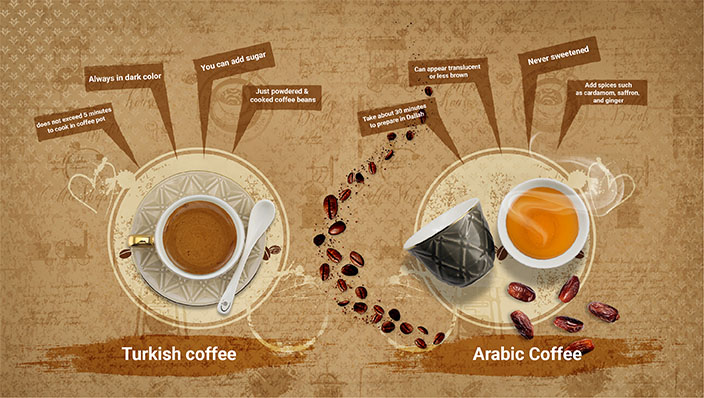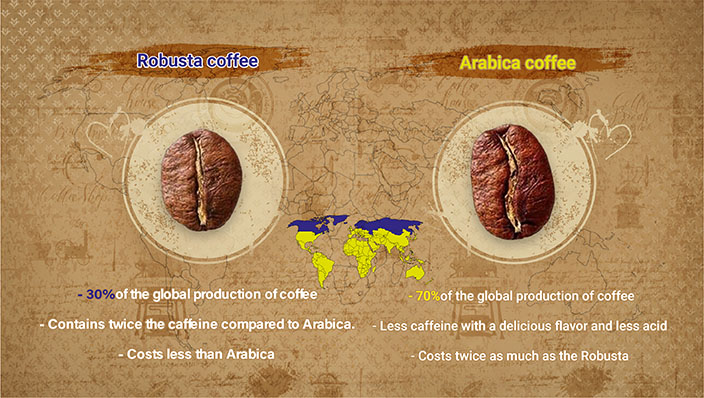For coffee lovers .. what you do not know about its origin and types
Arabic coffee occupies a large place in the Arab cultural heritage, Part of it is related to the Arab culture of generosity and hospitality, the other part is related to the effect of coffee and the mood presented while drinking it, especially because of high levels of caffeine in the coffee, which can stimulate the nervous system, overcome laziness, and many other benefits.
Index:
- The origin of coffee.
- Arabic coffee.
- What are the differences between Arabic coffee and Turkish coffee?
- The types of coffee.
- Summary.
The origin of the coffee
- “Qahwa” is an Arabic word derived from “Kahye” which means in Arabic appetite suppressant, this is because coffee has been known as a reduced hunger drink, it’s known also as “Kahve” in the Turkish language, while the “coffee” word in English was derived from the Scottish word “Koffie “.
- Sufis in Yemen were the first to take it to stay awake for worship at night. After that, coffee moved to “Makkah”, Egypt and Levant countries, then to Turkey and Europe. Thus, the Arabs presented coffee as a gift to the world.
- The coffee in the Arabian Peninsula differs from that in Egypt and the Levant, as it was known for the spices that are added to it during the preparation process, and it was prepared in a jug known as “Dallah”, and it was always served accompanied by dates.
- Arabic coffee has special utensils used in the preparation, such as “Dallah” and Thermoses, which can keep the temperature of the coffee hot for a long time, so that we can prepare a large amount of it while keeping it hot as long as possible.
Arabic coffee
- Arabic coffee is a part of the culture of many Arab countries, it is presented in councils and family meetings, it has a lot of lovers, and today it is an essential item in every house. Although its presence in the past was limited to "tribal sheikhs", now it has been included in the representative list of the intangible cultural heritage of the Organization United Nations Educational, Scientific and Cultural Organization last 2015.
- The Kingdom of Saudi Arabia gets the lion's share of coffee consumption in the Middle East, according to the statistics announced in December 2019, the size of the coffee market in Saudi Arabia only is estimated at 6 billion riyals, at a time when the size of the Middle East coffee market is 11 billion dollars.
- In the United Arab Emirates, the size of the coffee market has reached 3 billion dirhams by 2021, according to the Ken Research Foundation, which specializes in market research, which has confirmed its expectations for a compound annual growth of 8.9% annually.
What are the differences between Arabic coffee and Turkish coffee?

The method of making coffee differs from one country to another, but Arabic coffee and Turkish coffee are the two most popular types of coffee presented, and the following are the most important differences between them.
- Both types are made from coffee beans.
- In Arabic coffee, we add spices to coffee beans such as cardamom, saffron and ginger, while Turkish coffee is just powdered & cooked beans.
- Arabic coffee is never sweetened, while you can add sugar to Turkish coffee as you taste.
- Arabic coffee can appear translucent or less brown, as it’s roasted in a short time compared to Turkish coffee that is always in dark color.
- Arabic coffee can take about 30 minutes to prepare, while Turkish coffee does not exceed 5 minutes to cook.
The types of coffee beans
- Coffee is an evergreen tree whose ripe fruits are red, and the fruit is peeled and some use it to make coffee peel, and coffee trees grow in a tropical climate.
- The Yemenis roasted and Chopped coffee, and after them, it began to be cultivated on a large scale in different regions around the world, such as Brazil, Vietnam, Colombia, Indonesia, and others.
- Although there are 100 types of coffee trees grown around the world, there are two widely cultivated.
Arabica coffee
- Arabica coffee is known for its delicious flavor and less acidity, it’s also the most popular type around the world.
- Its production is 70% of the global production of coffee. We prepare Arabic coffee and all kinds of that type of coffee, which contains less caffeine as well as chlorogenic acid, but it is more expensive in price.
- The Arabica tree takes 7 years to start production, and it is cultivated in countries such as Ethiopia, Kenya, Rwanda, Tanzania, Yemen, and southern Saudi Arabia, in addition to Colombia, Peru, Costa Rica, Guatemala, and El Salvador, and in places higher than 600 meters, thus the harvesting process is more difficult and requires more labor.
Robusta coffee
- Its production is 30% of the global production of coffee.
- It’s ranked second in terms of global coffee production and contains twice the caffeine compared to arabica coffee.
- It’s cultivated in countries such as Vietnam, India, and Indonesia.
- The Robusta tree is resistant to diseases because it contains high levels of caffeine that repels insects, and the tree takes less time than the Arabica tree to start the production process from 2 to 3 years.
Difference between Arabica and Robusta

The main difference between the two types is in the shape, as you find the Robusta beans round while the Arabica beans are oval, and about the size term, the Arabica beans are slightly larger than the Robusta beans.
The second difference is the percentage of sugar and fats, as fats make up 60% of the composition of Arabica, it also contains twice the amount of sugars compared to Robusta, and the sugars play an important role during the roasting process to create many flavors.
The third difference is caffeine and chlorogenic acid, as Robusta contains twice the amount of caffeine.
The fourth difference is the cost, as the Arabica tree costs twice as much as Robusta, but its taste and acidity are its most important advantages, which makes up for its cost.
Robusta is used as part of espresso blends, and Robusta helps coffee shops reduce the cost because it is cheaper than Arabica, but baristas know that the flavor of Robusta is less desirable compared to Arabica.
Summary
- Arabic coffee occupies a large place in the Arab cultural heritage, it has also a great position which made the market for coffee in the Middle East reach 11 billion dollars.
- Yemen is the origin of coffee beans, then it moved to the Arabian Peninsula and from there to Egypt and the Levant, then Turkey and the countries of Europe.
- Arabic coffee differs from Turkish coffee in its shape and method of preparation and also the tools we use to prepare.
- There are many types of coffee that are grown in tropical countries, the most popular coffee beans are Robusta and Arabica.

